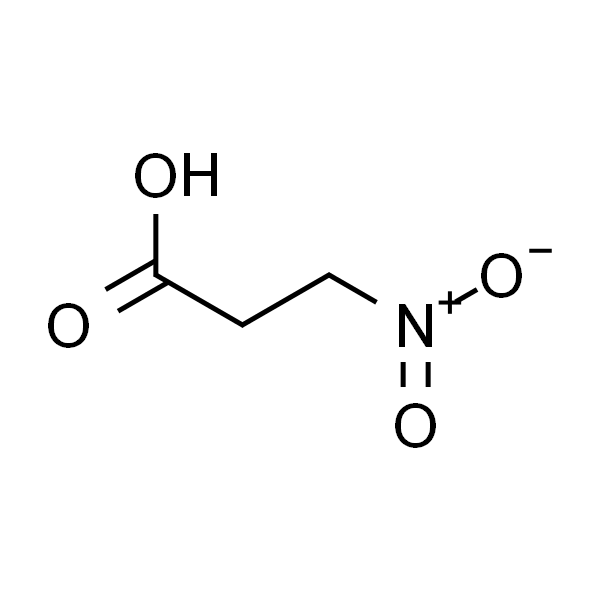3-硝基丙酸
货号:
IN1610
品牌:
Jinpan

暂无详情
产品简介
| 有效期 | 2年 |
| MDL | MFCD00007406 |
| EC | EINECS 208-003-0 |
| InChIKey | WBLZUCOIBUDNBV-UHFFFAOYSA-N |
| InChI | InChI=1S/C3H5NO4/c5-3(6)1-2-4(7)8/h1-2H2,(H,5,6) |
| PubChem CID | 1678 |
| 别名 | 3-氮丙酸 |
| 英文名称 | 3-Nitropropionic Acid |
| CAS | 504-88-1 |
| 分子式 | C3H5NO4 |
| 分子量 | 119.08 |
| 储存条件 | 2-8℃ |
| 纯度 | ≥98% |
| 外观(性状) | White to pale yellow Powder |
| 单位 | 瓶 |
| 生物活性 | 3-Nitropropionic acid (β-Nitropropionic Acid, 3-NP) is an irreversible inhibitor of mitochondrial respiratory Complex II succinate dehydrogenase, resulting in energy depletion through disruption of the electron transport chain.[1-3] |
| In Vitro | 3-nitropropionic acid (3-NPA) is an irreversible inhibitor of complex II in the mitochondria. It impairs cellular energy metabolism via inhibition of succinate dehydrogenase, which induces a reduction in ATP production and leads to oxidative stress. 3-NPA can cause the generation and release of ROS from mitochondria, mitochondrial DNA damage, and thus loss of mitochondrial function. 3-NPA reduces the number of large follicles, impairs oocyte development, and increases the percentage of atretic large follicles and ROS levels in oocytes and granulosa cells[2]. ROS production followed by mitochondrial DNA damage is the primary event in 3-NPA toxicity, and Bcl-2 protects PC12 cells from 3-NPA toxicity by preventing mitochondrial DNA damage[3]. |
| In Vivo | Female ICR mice were dosed with 3-nitropropionic acid(3-NPA) at three different concentrations (6.25, 12.5 and 25 mg/kg) and saline (control) via continuous intraperitoneal injection for 7 days. The treatment with 12.5 mg/kg reduced the weight of mouse ovaries, and significantly increased ROS levels and the activities of antioxidant enzymes—total superoxide dismutase (T-SOD), glutathione peroxidase (GPx) and catalase (CAT) — in granulosa cells and ovarian tissues, but not in other tissues (brain, liver, kidney and spleen). The same treatment significantly increased the percentage of atretic large follicles, and reduced the number of large follicles, the number of ovulated oocytes, and the capacity for early embryonic development compared with controls. It also significantly decreased the ratio of Bcl-2 to Bax, while causing an increase in the mRNA expression of (SOD2, CAT and GPX) and ROS levels in granulosa cells. Collectively, these data indicate that 3-NPA induces granulosa cell apoptosis, large follicle atresia, and an increase of ROS levels in the ovary. [2] |
| 激酶实验 | After 3-NPA (12.5 mg/kg) treatment for seven days, different tissues (ovary, brain, spleen, liver and kidney) were collected. Separately, tissue from each of the five sampled organs (ovary, brain, spleen, liver and kidney) was homogenized in cold saline to prepare for the assay for activity of antioxidant enzymes.[2] |
| SMILES | O=C(O)CC[N+]([O-])=O |
| 靶点 | succinate dehydrogenase |
| 动物实验 | Viability of the PC12 cells with or without treatment of 3-NPA is estimated using trypan blue exclusion test. Cells are grown in Petri dishes to a density of 1 × 106 cells/dish. After treatment with 4 or 8 mM 3-NPA for 48 h, cells are washed with Hank’s balanced salt solution. Trypan blue (0.4 %) is added to the cells and incubated for 5 min. Both viable and nonviable cells are scored on a hemocytometer using a Nikon microscope. The nonviable cells are expressed as a percentage of total cell population[3] |
| 细胞实验 | Female, 4-week-old ICR mice were kept at a constant temperature (22–24uC) in a 12 hr light/dark cycle with unrestricted access to food and water. For injection, 3-NPA was dissolved in normal saline and the pH was adjusted to 7.4 with sodium hydroxide. Mice were randomly divided into four treatment groups (n = 20): (i) injected with normal saline solution (control); (ii) treated with 6.25 mg/kg 3-NPA; (iii) treated with 12.5 mg/kg 3-NPA; (iv) treated with 25 mg/kg 3-NPA; The control and experimental groups were injected intraperitoneally with a 0.1 ml dose of the appropriate solution twice daily, at 12 h intervals (8:00 a.m. and 8:00 p.m.) for 7 days. Weight gain, body and organ weights of mice treated with different doses of 3-NPA (6.25, 12.5 and 25 mg/kg) and control were measured at 8 days.[2] |
| 数据来源文献 | [1] Huang LS, et al. J Biol Chem. 2006, 281(9):5965-72. [2] Zhang JQ, et al. PLoS One. 2014, 9(2):e86589. [3] Mandavilli BS, et al. Brain Res Mol Brain Res. 2005, 133(2):2 |
| 规格 | 100mg 200mg |
是琥珀酸脱氢酶的不可逆抑制剂。
